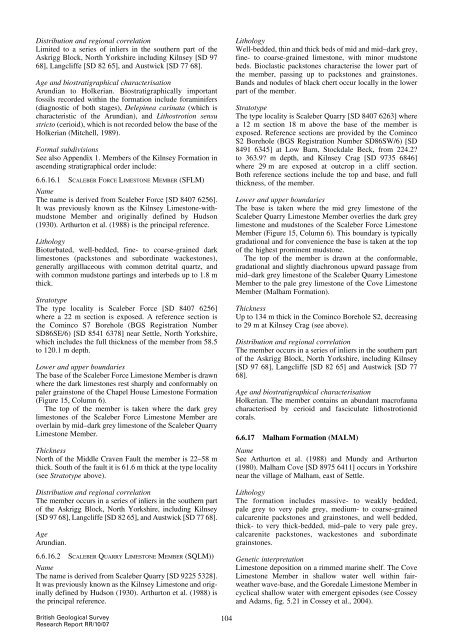A lithostratigraphical framework for the Carboniferous successions of
A lithostratigraphical framework for the Carboniferous successions of
A lithostratigraphical framework for the Carboniferous successions of
You also want an ePaper? Increase the reach of your titles
YUMPU automatically turns print PDFs into web optimized ePapers that Google loves.
Distribution and regional correlation<br />
limited to a series <strong>of</strong> inliers in <strong>the</strong> sou<strong>the</strong>rn part <strong>of</strong> <strong>the</strong><br />
Askrigg Block, North yorkshire including Kilnsey [sd 97<br />
68], langcliffe [sd 82 65], and Austwick [sd 77 68].<br />
Age and biostratigraphical characterisation<br />
Arundian to Holkerian. Biostratigraphically important<br />
fossils recorded within <strong>the</strong> <strong>for</strong>mation include <strong>for</strong>aminifers<br />
(diagnostic <strong>of</strong> both stages), Delepinea carinata (which is<br />
characteristic <strong>of</strong> <strong>the</strong> Arundian), and Lithostrotion sensu<br />
stricto (cerioid), which is not recorded below <strong>the</strong> base <strong>of</strong> <strong>the</strong><br />
Holkerian (mitchell, 1989).<br />
Formal subdivisions<br />
see also Appendix 1. members <strong>of</strong> <strong>the</strong> Kilnsey Formation in<br />
ascending stratigraphical order include:<br />
6.6.16.1 sCaleBer ForCe liMesTone MeMBer (sFlM)<br />
Name<br />
The name is derived from scaleber Force [sd 8407 6256].<br />
it was previously known as <strong>the</strong> Kilnsey limestone-withmudstone<br />
member and originally defined by Hudson<br />
(1930). Arthurton et al. (1988) is <strong>the</strong> principal reference.<br />
Lithology<br />
Bioturbated, well-bedded, fine- to coarse-grained dark<br />
limestones (packstones and subordinate wackestones),<br />
generally argillaceous with common detrital quartz, and<br />
with common mudstone partings and interbeds up to 1.8 m<br />
thick.<br />
Stratotype<br />
The type locality is scaleber Force [sd 8407 6256]<br />
where a 22 m section is exposed. A reference section is<br />
<strong>the</strong> Cominco s7 Borehole (BGs Registration Number<br />
sd86se/6) [sd 8541 6378] near settle, North yorkshire,<br />
which includes <strong>the</strong> full thickness <strong>of</strong> <strong>the</strong> member from 58.5<br />
to 120.1 m depth.<br />
Lower and upper boundaries<br />
The base <strong>of</strong> <strong>the</strong> scaleber Force limestone member is drawn<br />
where <strong>the</strong> dark limestones rest sharply and con<strong>for</strong>mably on<br />
paler grainstone <strong>of</strong> <strong>the</strong> Chapel House limestone Formation<br />
(Figure 15, Column 6).<br />
The top <strong>of</strong> <strong>the</strong> member is taken where <strong>the</strong> dark grey<br />
limestones <strong>of</strong> <strong>the</strong> scaleber Force limestone member are<br />
overlain by mid–dark grey limestone <strong>of</strong> <strong>the</strong> scaleber Quarry<br />
limestone member.<br />
Thickness<br />
North <strong>of</strong> <strong>the</strong> middle Craven Fault <strong>the</strong> member is 22–58 m<br />
thick. south <strong>of</strong> <strong>the</strong> fault it is 61.6 m thick at <strong>the</strong> type locality<br />
(see Stratotype above).<br />
Distribution and regional correlation<br />
The member occurs in a series <strong>of</strong> inliers in <strong>the</strong> sou<strong>the</strong>rn part<br />
<strong>of</strong> <strong>the</strong> Askrigg Block, North yorkshire, including Kilnsey<br />
[sd 97 68], langcliffe [sd 82 65], and Austwick [sd 77 68].<br />
Age<br />
Arundian.<br />
6.6.16.2 sCaleBer Quarry liMesTone MeMBer (sQlM))<br />
Name<br />
The name is derived from scaleber Quarry [sd 9225 5328].<br />
it was previously known as <strong>the</strong> Kilnsey limestone and originally<br />
defined by Hudson (1930). Arthurton et al. (1988) is<br />
<strong>the</strong> principal reference.<br />
British Geological Survey<br />
Research Report RR/10/07<br />
104<br />
Lithology<br />
well-bedded, thin and thick beds <strong>of</strong> mid and mid–dark grey,<br />
fine- to coarse-grained limestone, with minor mudstone<br />
beds. Bioclastic packstones characterise <strong>the</strong> lower part <strong>of</strong><br />
<strong>the</strong> member, passing up to packstones and grainstones.<br />
Bands and nodules <strong>of</strong> black chert occur locally in <strong>the</strong> lower<br />
part <strong>of</strong> <strong>the</strong> member.<br />
Stratotype<br />
The type locality is scaleber Quarry [sd 8407 6263] where<br />
a 12 m section 18 m above <strong>the</strong> base <strong>of</strong> <strong>the</strong> member is<br />
exposed. Reference sections are provided by <strong>the</strong> Cominco<br />
s2 Borehole (BGs Registration Number sd86sw/6) [sd<br />
8491 6345] at low Barn, stockdale Beck, from 224.2?<br />
to 363.9? m depth, and Kilnsey Crag [sd 9735 6846]<br />
where 29 m are exposed at outcrop in a cliff section.<br />
Both reference sections include <strong>the</strong> top and base, and full<br />
thickness, <strong>of</strong> <strong>the</strong> member.<br />
Lower and upper boundaries<br />
The base is taken where <strong>the</strong> mid grey limestone <strong>of</strong> <strong>the</strong><br />
scaleber Quarry limestone member overlies <strong>the</strong> dark grey<br />
limestone and mudstones <strong>of</strong> <strong>the</strong> scaleber Force limestone<br />
member (Figure 15, Column 6). This boundary is typically<br />
gradational and <strong>for</strong> convenience <strong>the</strong> base is taken at <strong>the</strong> top<br />
<strong>of</strong> <strong>the</strong> highest prominent mudstone.<br />
The top <strong>of</strong> <strong>the</strong> member is drawn at <strong>the</strong> con<strong>for</strong>mable,<br />
gradational and slightly diachronous upward passage from<br />
mid–dark grey limestone <strong>of</strong> <strong>the</strong> scaleber Quarry limestone<br />
member to <strong>the</strong> pale grey limestone <strong>of</strong> <strong>the</strong> Cove limestone<br />
member (malham Formation).<br />
Thickness<br />
up to 134 m thick in <strong>the</strong> Cominco Borehole s2, decreasing<br />
to 29 m at Kilnsey Crag (see above).<br />
Distribution and regional correlation<br />
The member occurs in a series <strong>of</strong> inliers in <strong>the</strong> sou<strong>the</strong>rn part<br />
<strong>of</strong> <strong>the</strong> Askrigg Block, North yorkshire, including Kilnsey<br />
[sd 97 68], langcliffe [sd 82 65] and Austwick [sd 77<br />
68].<br />
Age and biostratigraphical characterisation<br />
Holkerian. The member contains an abundant macr<strong>of</strong>auna<br />
characterised by cerioid and fasciculate lithostrotionid<br />
corals.<br />
6.6.17 Malham Formation (MALM)<br />
Name<br />
see Arthurton et al. (1988) and mundy and Arthurton<br />
(1980). malham Cove [sd 8975 6411] occurs in yorkshire<br />
near <strong>the</strong> village <strong>of</strong> malham, east <strong>of</strong> settle.<br />
Lithology<br />
The <strong>for</strong>mation includes massive- to weakly bedded,<br />
pale grey to very pale grey, medium- to coarse-grained<br />
calcarenite packstones and grainstones, and well bedded,<br />
thick- to very thick-bedded, mid–pale to very pale grey,<br />
calcarenite packstones, wackestones and subordinate<br />
grainstones.<br />
Genetic interpretation<br />
limestone deposition on a rimmed marine shelf. The Cove<br />
limestone member in shallow water well within fairwea<strong>the</strong>r<br />
wave-base, and <strong>the</strong> Goredale limestone member in<br />
cyclical shallow water with emergent episodes (see Cossey<br />
and Adams, fig. 5.21 in Cossey et al., 2004).

















